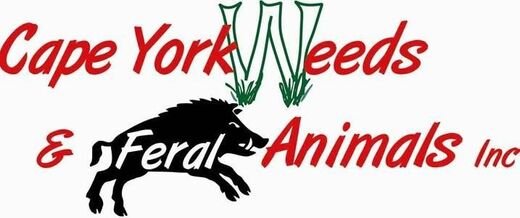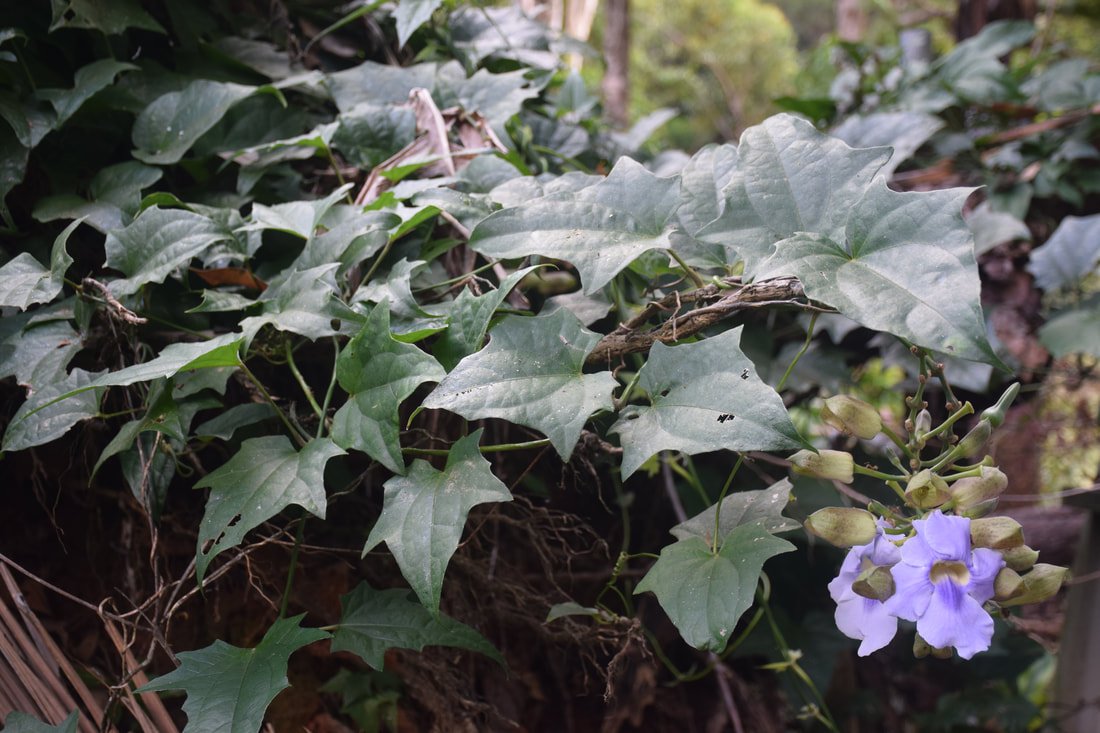Thunbergia Control Program Progress Report October 2017
In June 2017, Cape York Weeds & Feral Animals were successful in obtaining conservation funding under Round One of the Community Sustainability Action grant program.
• This has been possible with the help of the Department of Environment and Heritage Protection.
• Thunbergia grandiflora classified as a "Level 1" weed has the potential to greatly expand its distribution within a suitable habitat, in this case rainforest areas.
• Both of these locations, Rossville and Bloomfield, consist of, and are encircled by tropical rainforest.
• As far as we can ascertain from extensive survey work that has been conducted throughout Cape York Peninsula over a 25 year period, the thunbergia only seems to occur in these two known areas.
• These locations are also adjacent to the World Heritage Wet Tropics Area and have no physical impediment to prevent transition to these areas if left unchecked.
• This weed has the ability to easily reach the canopy of mature rainforest vegetation.
• It will kill palm trees by binding the crown, smothering other trees, and causing extensive branch braking and tree fall under the weight of the dense vine mass.
• The result of an infestation of thunbergia on rainforest areas is a greatly altered forest structure with vulnerable vegetation being eliminated. This will also have a negative impact on fauna which are dependent on the natural rainforest habitat.
• Most importantly control work will prevent this destructive weed from establishing in this part of the World Heritage Wet Tropics rainforest – if we are not too late.
• Thunbergia grandiflora classified as a "Class 1" weed as Restricted Matter Category 1 under Security Act 2014.
The Thunbergia control program began on the 14th of August 2017.
• We began work at Whyalla Gardens in the Bloomfield area, and the following week went on to the infestation at Rossville.
• Control work was conducted over 15-man days during the initial control work, including in-kind work from Cape York Weeds and Feral Animals Incorporated.
• Liaised with the local landholders, on which these two infestations were located, within the Wet Tropics World Heritage Areas.
• All stakeholders were keen to fulfil their obligations under the Biosecurity Act.
• A strategic survey and control program was designed and established.
• A survey was carried out to determine the where and how the control work was to be undertaken.
• The Thunbergia was surveyed and is quite thick and covers localised areas, within these two rainforest sites.
• The majority of Thunbergia is very well established, being intertwined in amongst these rainforest canopies.
• This affects all native species and the natural ecosystems that are in this catchment area.
• The Thunbergia has the potential to spread further along the river and gully systems.
• Vehicles, humans and stock, travelling along these areas also have the capacity to spread it further. Because of the this, CYWAFA_ INC developed a comprehensive Strategic Control Plan.
• The infestation at Whyalla begins on the edge of a cleared area and extends into the adjacent rainforest and across a small stream. A secondary infestation was also discovered further down the stream where the driveway crossed. A preliminary survey of the stream did not locate any more plants, but a more extensive search will be conducted.
• The infestation was treated by exposing the underground tubers and stem injecting bio-degradable herbicide into them as well as stem injection into the stems.
• The landholders were very supportive of working in partnership.
• At the location in Rossville both of the landholders had done a considerable amount of control work on the infestation since the initial consultation.
• One of the landholders had cut the large vines and regularly applied glyphosate to the new root suckers.
• The other landholder had used glyphosate foliar spray and then fire to reduce the quantity of sprawling vine which had been spreading across some open area and steep banks.
• In this area the underground tubers were also exposed and injected and the stems were injected with bio-degradable herbicide as well.
• In the photo provided, a standing dead tree can be seen which has been stripped of its branches due to the weight of the vine. Three palm trees can be seen in a line where two have been killed and the third is in the process of being strangled by the vine.
• At both locations a fair amount of regrowth has occurred. Some of this would have been due to tubers and stems being missed, which is inevitable due to the dense viny thickets.
• Also, much of the regrowth was from areas where the landholders had used glyphosate which killed the above-ground plant but as we entered spring the remaining underground tubers began to sprout.
• This highlights the benefit of doing the job effectively as well as the value and importance of follow up treatment.
• Other weeds species controlled includes Singapore Daisy Sicklepod, Guinea Grass.
• Conducted a tool box talk and carried out a risk assessment before any control work was commenced.
• Peripheral areas such as the wider community of Rossville and the areas adjacent to the Whyalla Gardens property will be surveyed again when we do the follow up control.
Monitoring points were set up, using easily identifiable natural features as scale object.
• Over six hectares of strategic survey and control was carried out, including the opening up of the undergrowth so we could get at the Thunbergia.
• Even though there was only 0.4 ha of control work has been mapped, we had to cover a lot of area to follow the vine back to where they were growing from.
• As the areas was thick rainforest, we controlled what we could find.
• There was as far greater area surveyed (8-10 ha) to see if we could find out if it had spread.
• All areas of control work were mapped using the GIS and QGIS systems.
• All data has been sent to the Department of Environment and Heritage Protection.
• The data and herbicide usage sheets were also completed.
• Cape York Weeds and Feral Animals Incorporated spent as much time as possible controlling all trafficked areas, watering points, and high conservation areas.
• A follow up control program needs to be implemented to further protect and reduce the impact of Thunbergia in these fragile ecosystems and habitats.
• The Strategic Thunbergia Control Program that was conducted was extremely successful.
• Follow-up on regrowth has been programmed after the wet season.
The Department of Environment and Heritage Protection and Cape York Weeds & Feral Animals Incorporated, are to be commended for their professionalism and willingness to get the job done.









